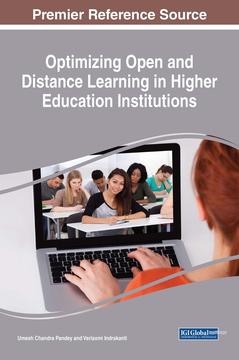
Optimizing Open and Distance Learning in Higher Education Institutions
Date Reviewed: January 18, 2019
What impact does education have upon a nation’s economy? Can education be used as a global instrument to overcome obstacles and foster change? These are just a few of the pivotal questions discussed throughout this resource that targets researchers and educators alike by introducing them to new theories and research concepts. This resource’s scholarly references and figures provide a broad perspective on trends and standards in higher education. The collection examines developing areas across the globe, the impact of initiatives on nations’ standings, and the connection between knowledge, economy, and technological capabilities in society. More importantly, this publication provides solutions for optimizing open and distance learning in higher education. It explores various developing nation’s policies regarding distance and open learning programs, obstacles and opportunities in higher education, as well as technological sustainability.
Optimizing Open and Distance Learning in Higher Education Institutions discusses how the “United Nations Development Programme (UNDP) creates policies for leadership skills, partnerships, and sustainable development” in developing areas (UNESCO, 2015). The research recognizes education as a global tool for tackling challenges and achieving change based on policies. It describes how development policies encourage higher education institutions to uniquely customize open and distance learning to suit individual growth needs and explains how customization then allows flexibility that combats cultural and socio-economic barriers. In developing nations, where continual changes in education and training rely upon such adaptability in education, open and distance learning can help to stabilize the economy and create a solid infrastructure.
Global cooperation creates a new dimension of challenges and opportunities in higher education. Learners are exposed to new techniques to improve skills and gain knowledge through open and distance learning by shifting toward learner-centered education and self-directed learning. Various contributors from around the globe form a fluid collection of writing grounded in research specific to open learning, distance learning, and e-learning.
This reference is highly recommended for researchers, educators, and students who seek to advance technology and education globally. This work explores gaps in theory and practice and offers recommendations for improvement. The different chapters analyze: e-learning, open and distance learning and education, higher education, quality assurance, trends, sustainability, and integration. Subtopics identify the services provided, access to education, management and capacity, technology equality, knowledge-based development, and sustainable growth in education. Further themes stress limitations, acquisition of “on the job” training components needed for employment, skills and technical proficiencies, and policy and research for technology integration. The collection not only details open and distance learning in higher education institutions in developing nations and efforts to overcome certain restrictions, but also creates polices for an educational path forward to reach goals of equality and sustainability.